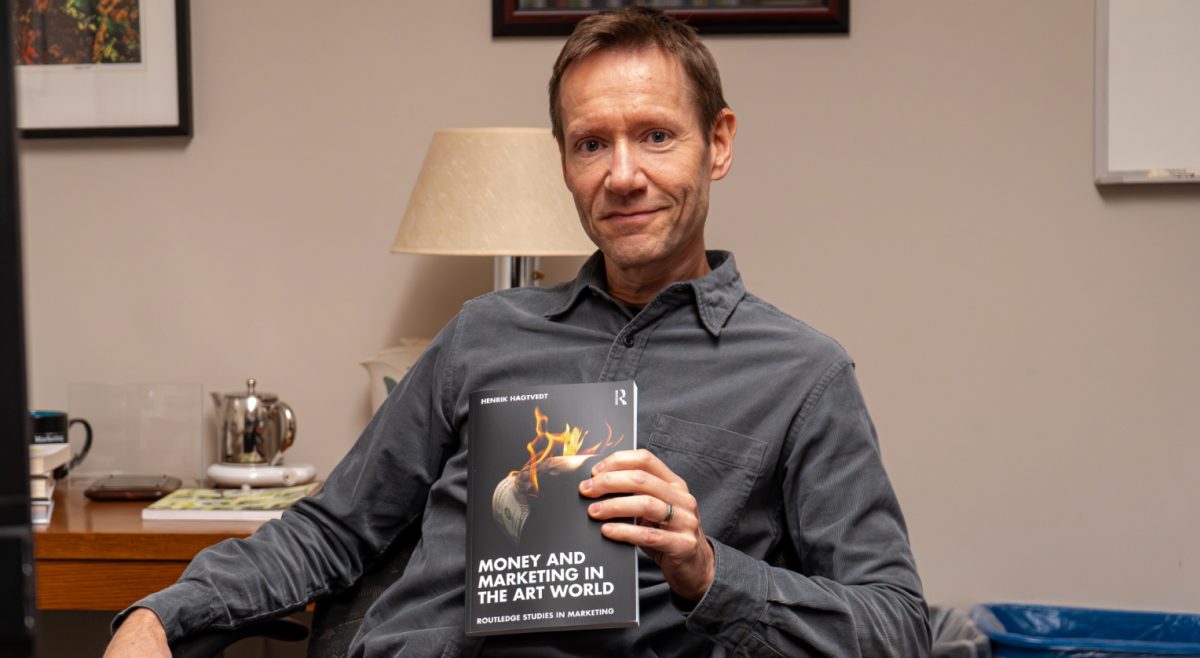
(Emily Ahern / Heights Editor)
When thinking about visual art, famous artists like Pablo Picasso and the colors or emotions their work conveys often come to mind.
But behind the canvas lie money and marketing— two powerful determinants of success in the art world.
Henrik Hagtvedt, chair of the Boston College marketing department and Michael A. Gooch Family Faculty Fellow, has spent the past two decades connecting design and marketing.
His research investigates the marketing of artwork—maximizing the impact of a visual on a viewer—and the art involved in marketing.
Hagtvedt hasn’t always worked in marketing, though. Before studying business, he worked as an artist himself. His painting career started when he was 19, and for a decade, he found success as a full-time artist.
“A lot of my research is informed by a lot of the interests that I’ve had my whole life,” Hagtvedt said. “A lot of my research ideas have come from insights I’ve had as a painter.”
Hagtvedt was drawn to academia after he found that success in the art world often depended more on trends than talent.
“I saw that a lot that was going on in the art world was driven by something else, other than just artistic quality or brilliance,” Hagtvedt said. “I got the impression that it operated in a certain way. Now that I know a lot more about marketing, a lot of what I thought then, which I guess I considered an insight now, is fairly obvious.”
Hagtvedt said his research is often driven by experiential knowledge and personal observations from his time as an artist.
Adam Brasel, an associate professor of marketing at BC, has partnered with Hagtvedt on research projects for 15 years. He emphasized that Hagtvedt’s connection to and interest in his research area is rare.
“[Hagtvedt] has a topic that he cares about so deeply that he’s able to explore both doing it in his previous life as an artist as well as really researching the underpinnings of it as an academic,” Brasel said. “We don’t always have that luxury.”
Kathleen Vohs, Distinguished McKnight University professor and Land O’Lakes professor in marketing at the University of Minnesota Twin Cities, worked on two research projects with Hagtvedt about finding meaning in art.
Hagtvedt made significant strides in expanding the field of art marketing, according to Vohs. She also noted how his artistic background allows him to bring special attention and expertise to his work.
“He not only comes at this from a scholarly perspective, where he’s able to bring theory and practice to the understanding of art in marketing, but he comes at it from a very personal angle as well,” Vohs said.
Initially, Hagtvedt said marketing journals weren’t receptive to the work he was interested in. Because few scholars have an interest in and experience with art marketing, the field remains relatively underdeveloped, he added.
“When it comes to most people who do research in the business world, they aren’t really familiar with the art world,” Hagtvedt said. “There’s a lot of space for additional research in a much bigger spotlight.”
In his work, Hagtvedt said he seeks to make knowledge about both fields more accessible to a broader audience. His first book, Money and Marketing in the Art World, published in October 2024, does just tha
As the title suggests, the book focuses on the role that money and marketing play in the art world.
According to Hagtvedt, the art world is often controlled by the invisible hand of the market and is not known for its transparency. Artists’ success, his book argues, is often based on their connections and on design trends, and knowledge about marketing is an important but often undervalued element of this landscape.
“I say a lot of things that aren’t really discussed in a lot of the writings on the topic of art. The role of marketing is often not even acknowledged,” Hagtvedt said.
Hagtvedt hopes his book will reach a wide audience and be both accessible and useful to readers beyond academia.
“It can certainly have something to inform some people who are working in art marketing,” Hagtvedt said. “It can be interesting for people interested in marketing as well, more broadly, even if they aren’t particularly interested in art, just because it’s a really fascinating market.”
The work Hagtvedt discusses in his book is becoming increasingly relevant to businesses and consumers, especially as the field of aesthetics in marketing continues to expand, according to Vohs.
“I think what people don’t realize is that art and aesthetics are a part of people’s everyday experience, especially in the marketplace,” Vohs said. “Firms work very hard to make their products visually appealing, as well as appealing to other sensory elements.”
As interest in marketing’s role in art continues to grow, Hagtvedt believes his and others’ research will become important to professionals who work in art marketing, not just to academics. Yet, the journals where this research is published are often not accessible to practitioners.
Brasel said Hagtvedt’s decision to publish a book will allow a broader audience to learn about art and marketing while helping the research reach those who will benefit from it most.
“Oftentimes, especially in the business school, book writing is not considered as important as academic papers and whatnot,” Brasel said. “But nobody outside of academics reads academic papers. [Hagtvedt] was really the driver behind that kind of project to kind of get his stuff out to the people who could actually use it.”
For Hagtvedt, it all comes back to benefitting society.
“I think art is very, very valuable and important for humankind,” Hagtvedt said. “I think marketing and business [are] very important and valuable for humankind. We should know the interactive roles that might be played, and we should just generally have transparency about how the art market works.”